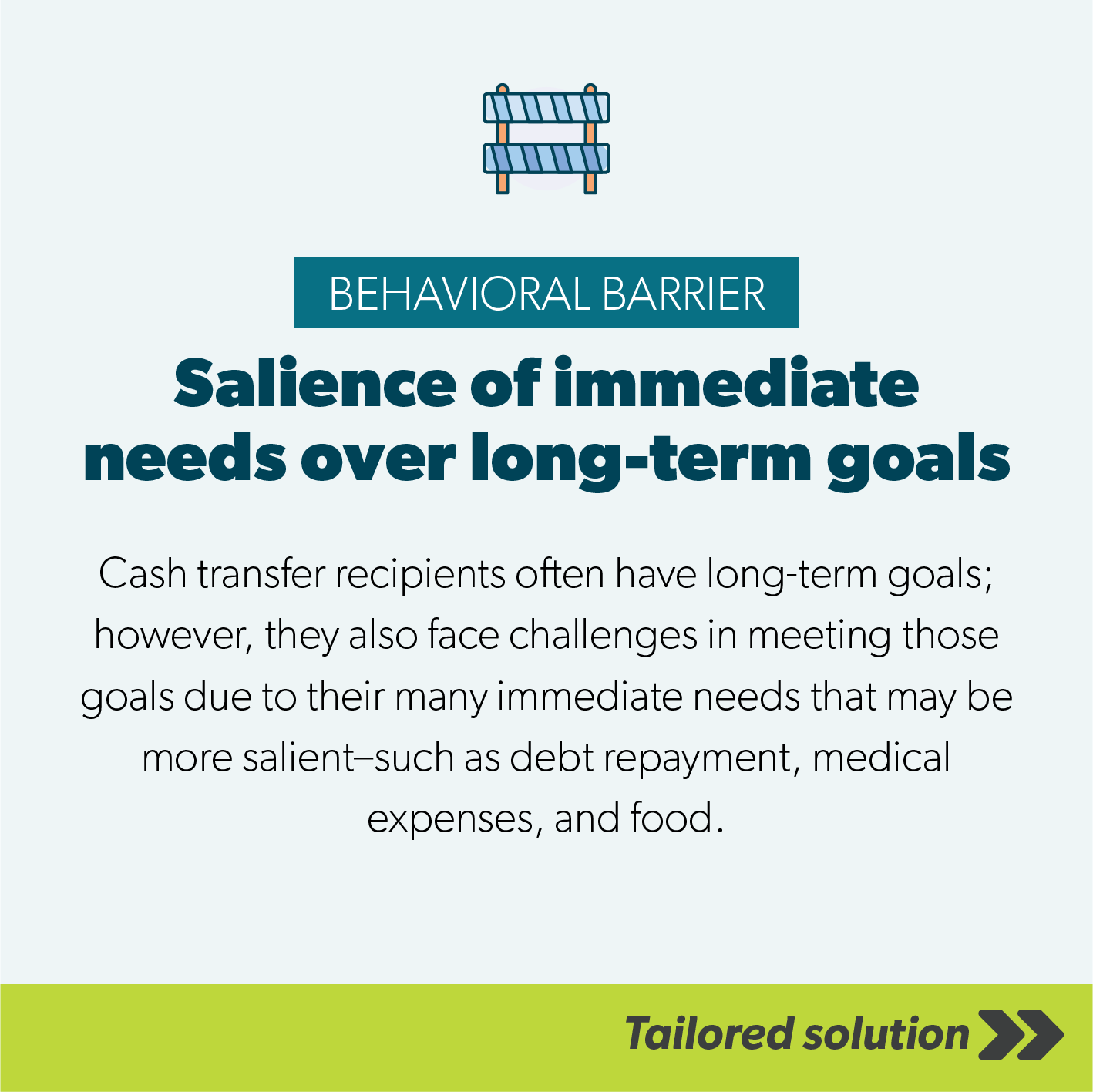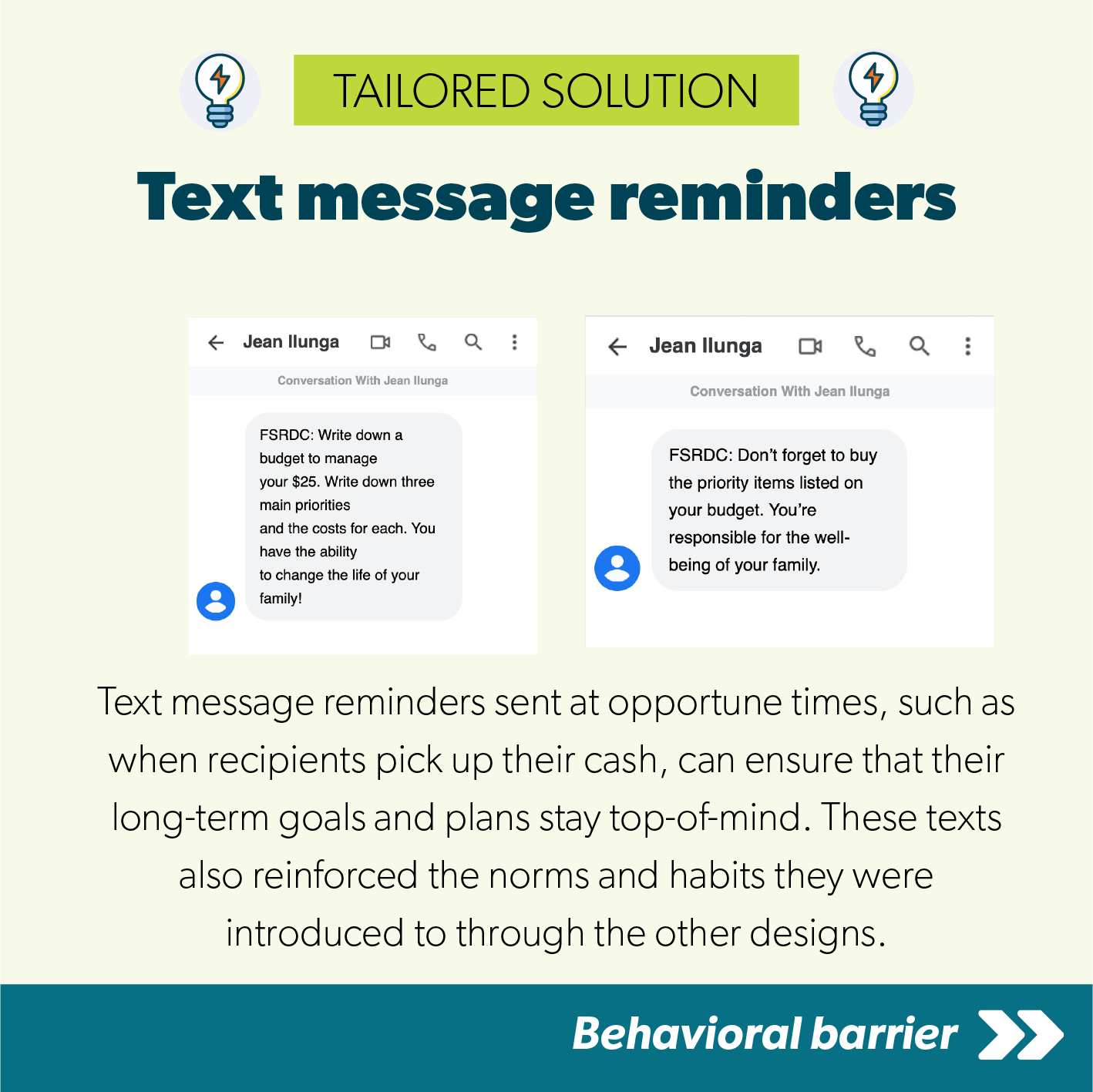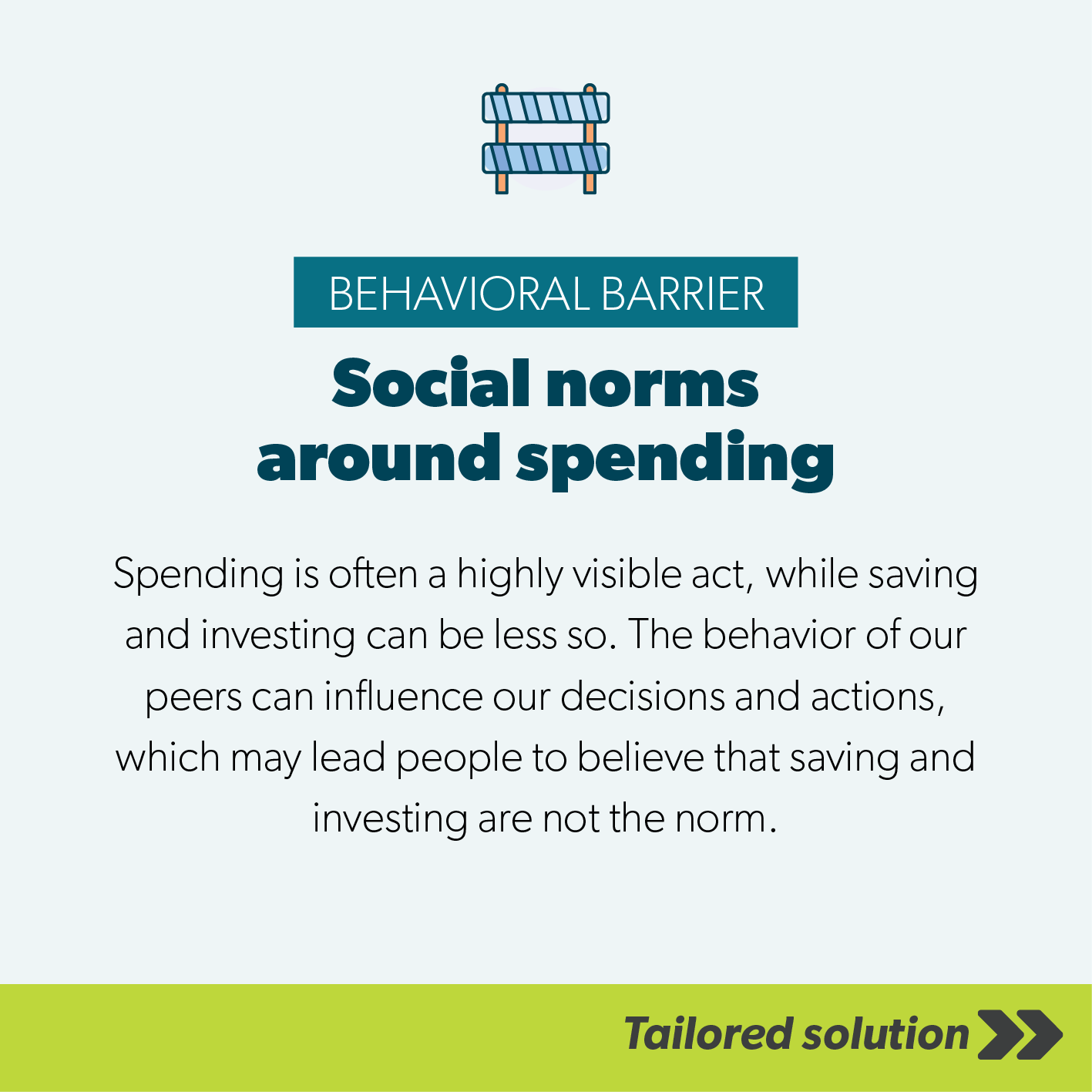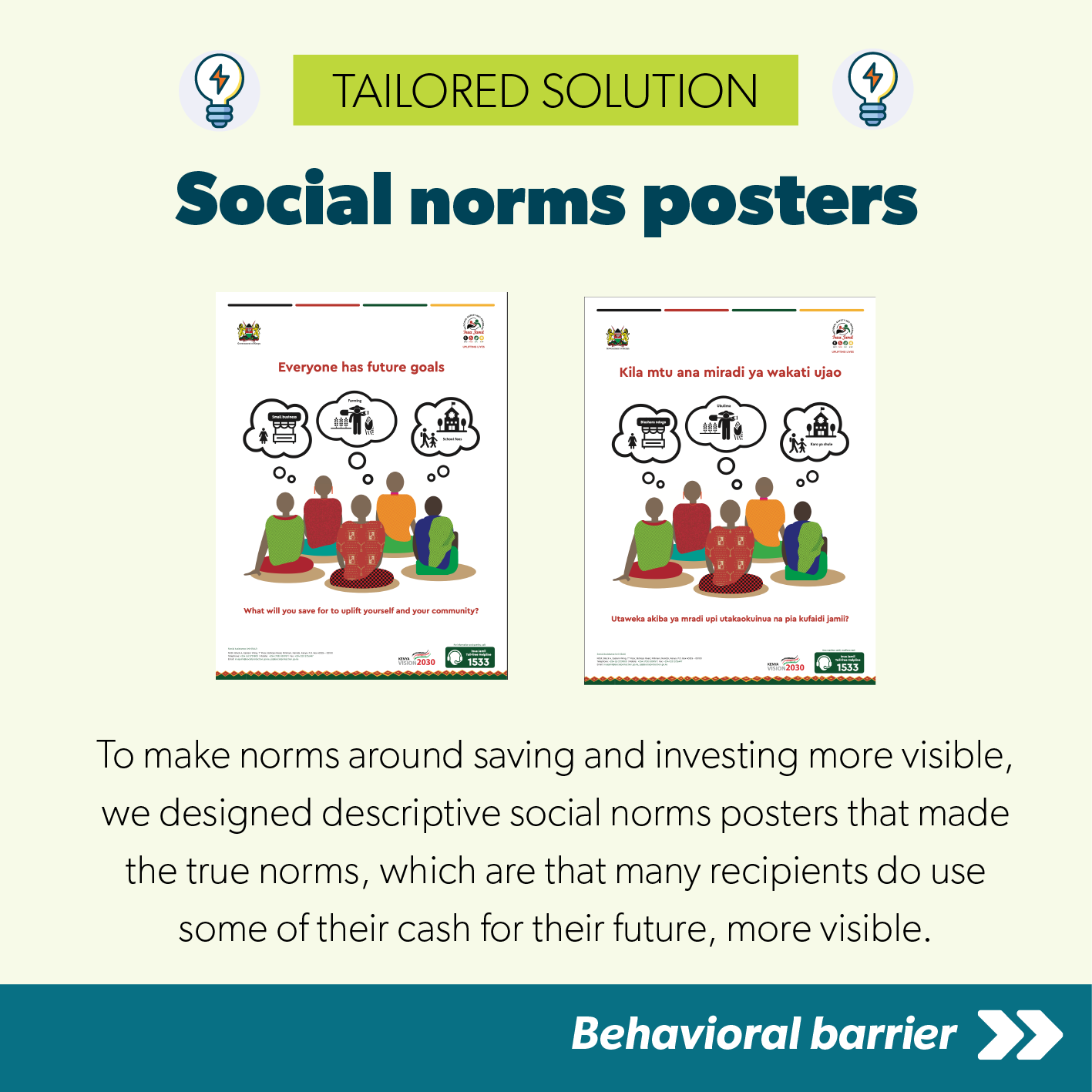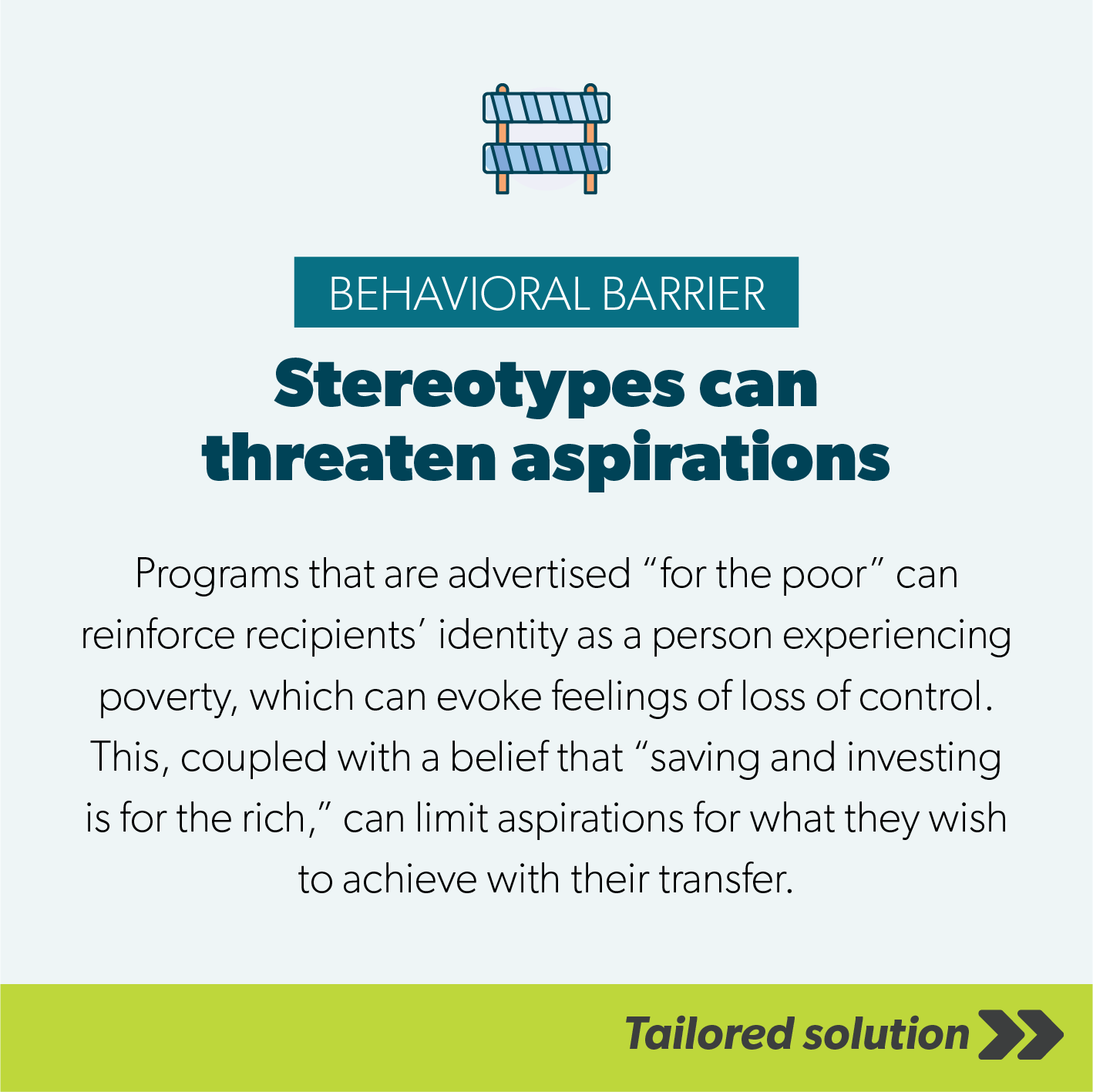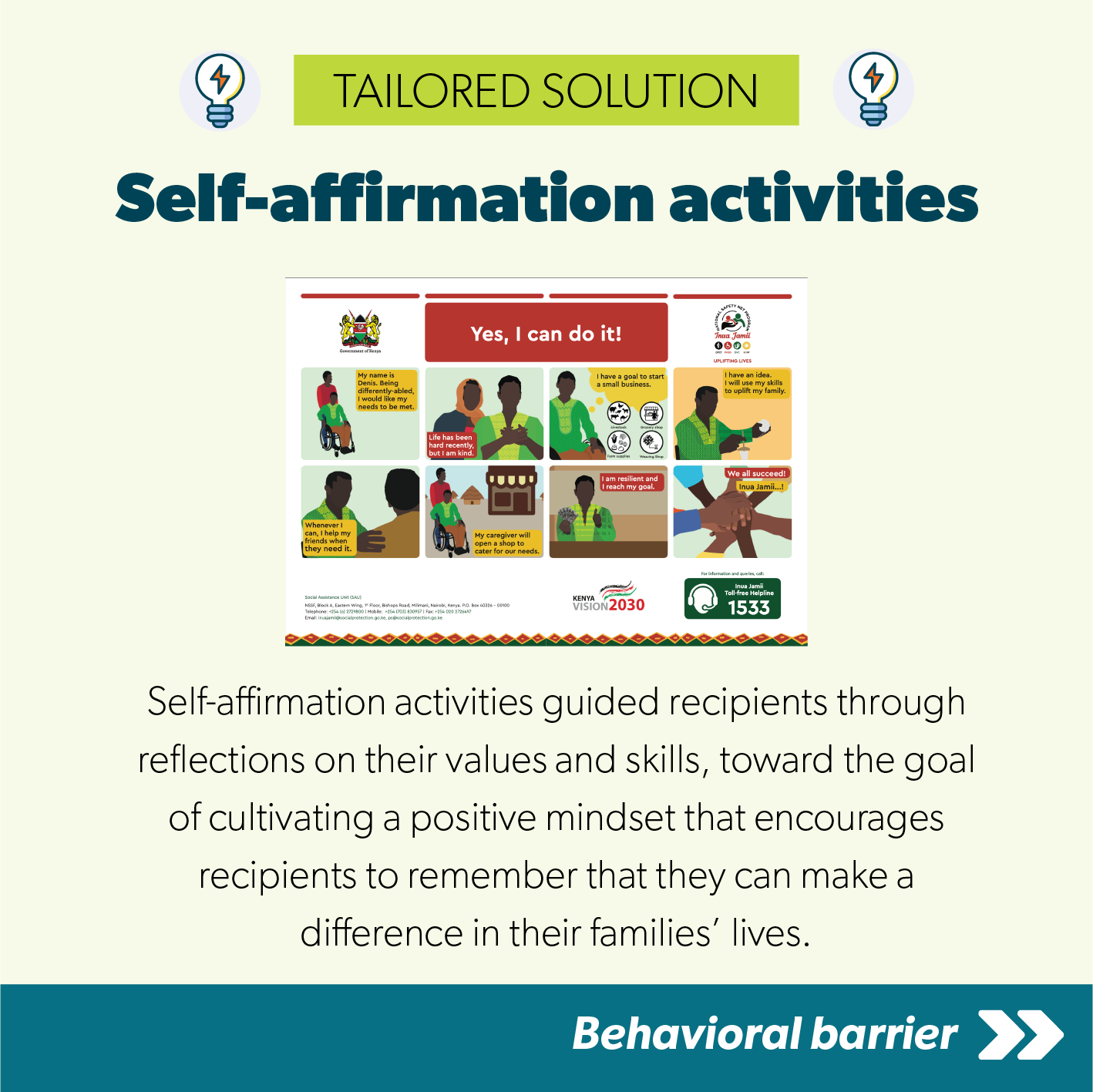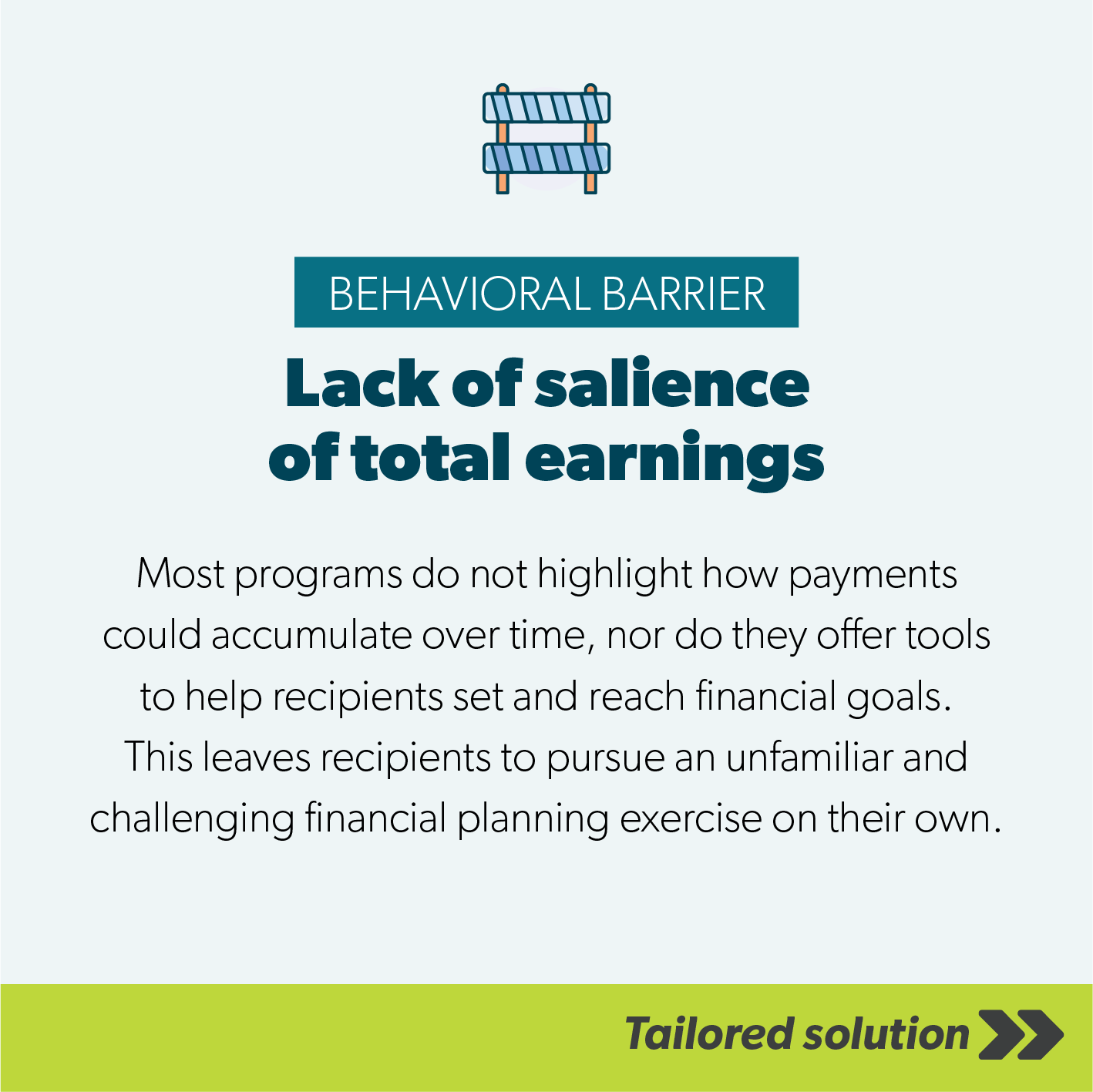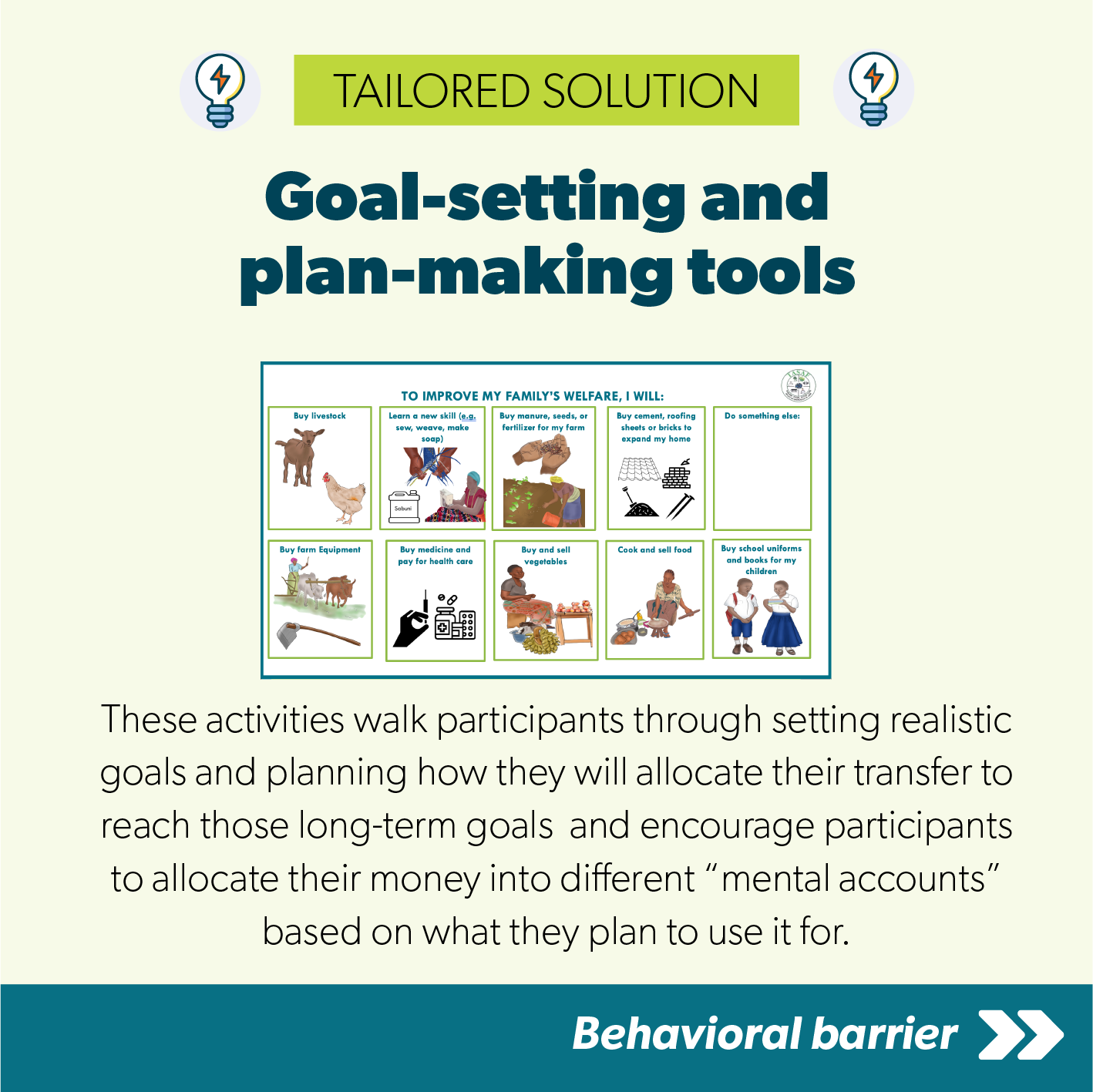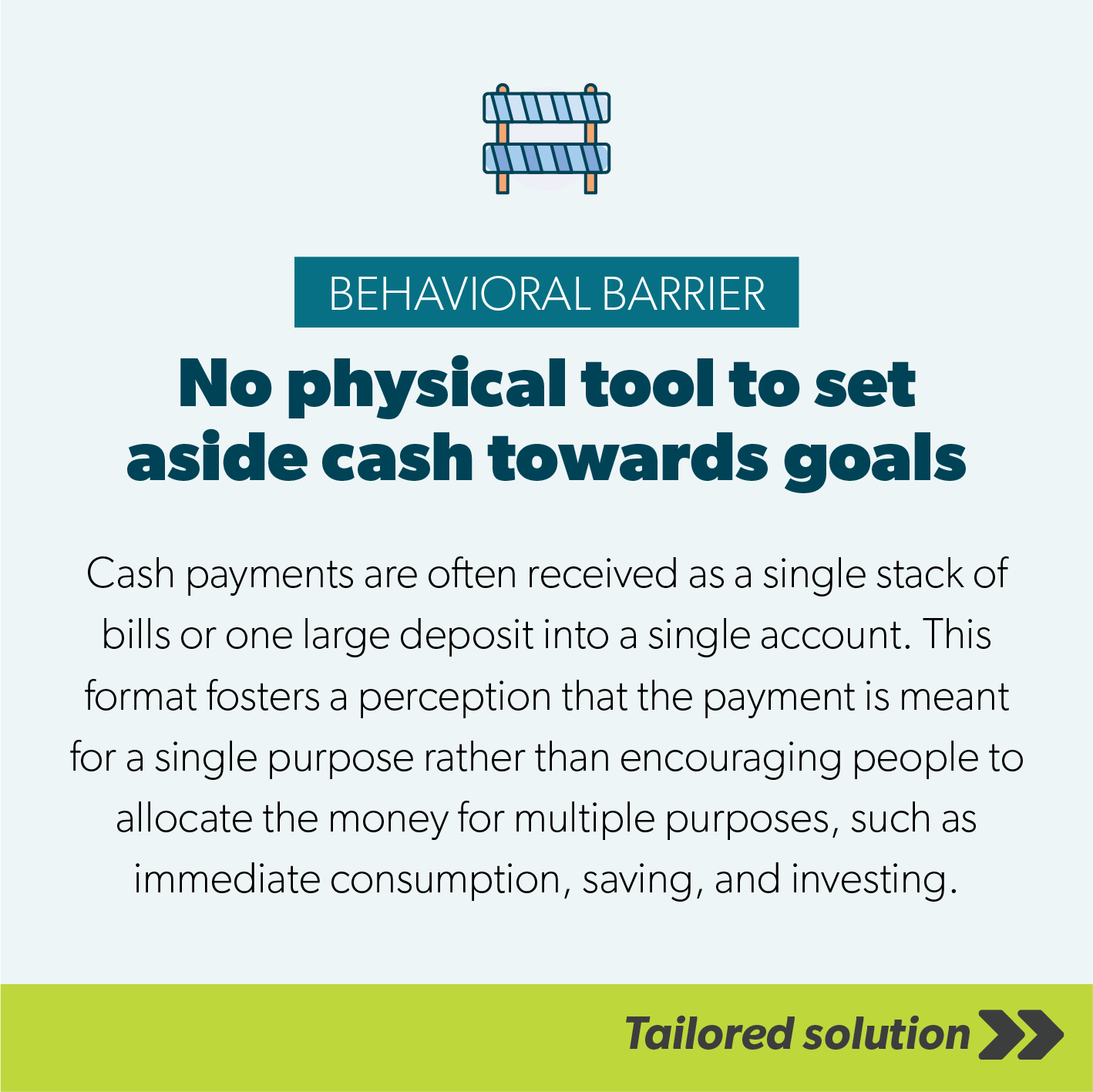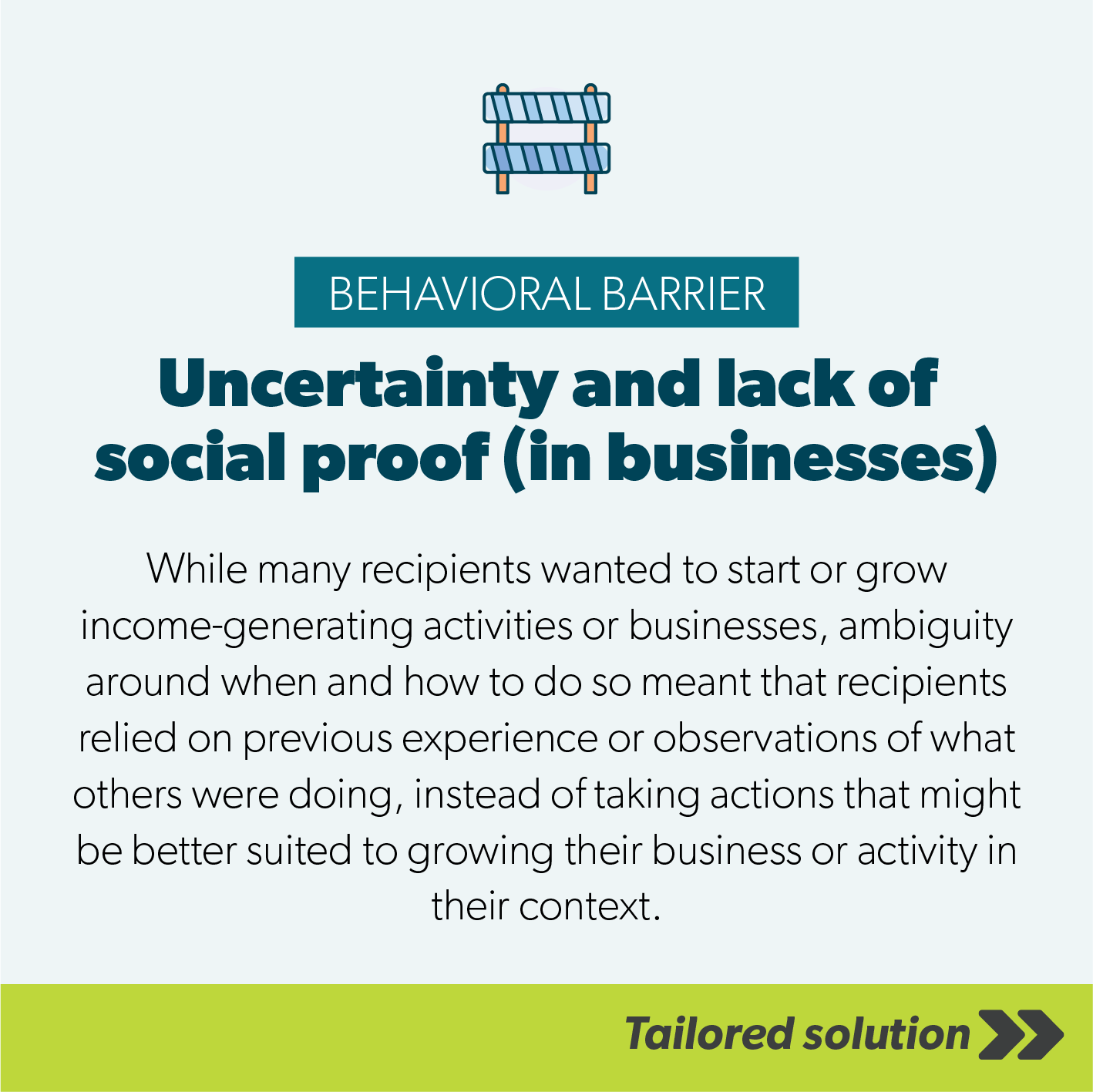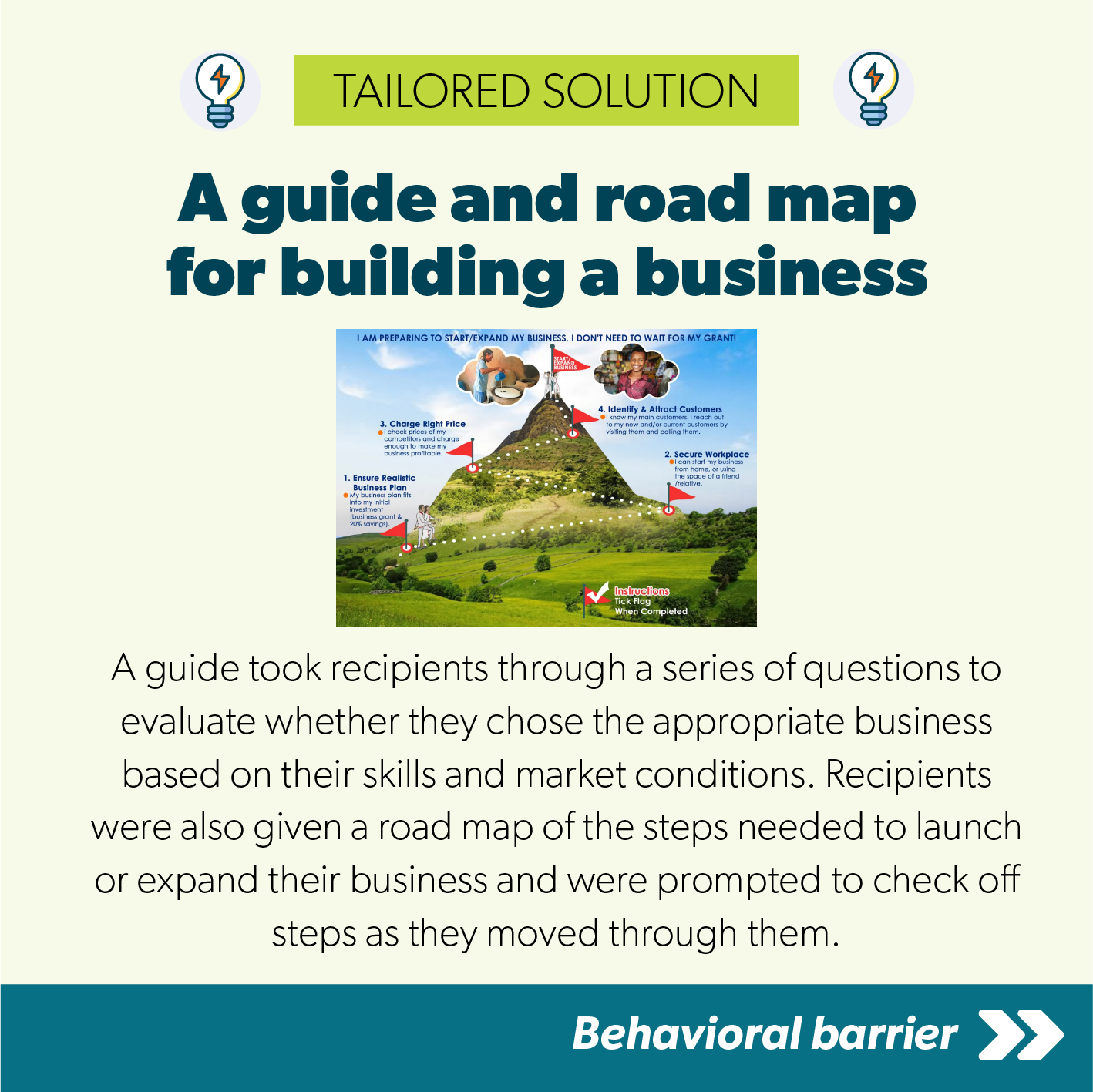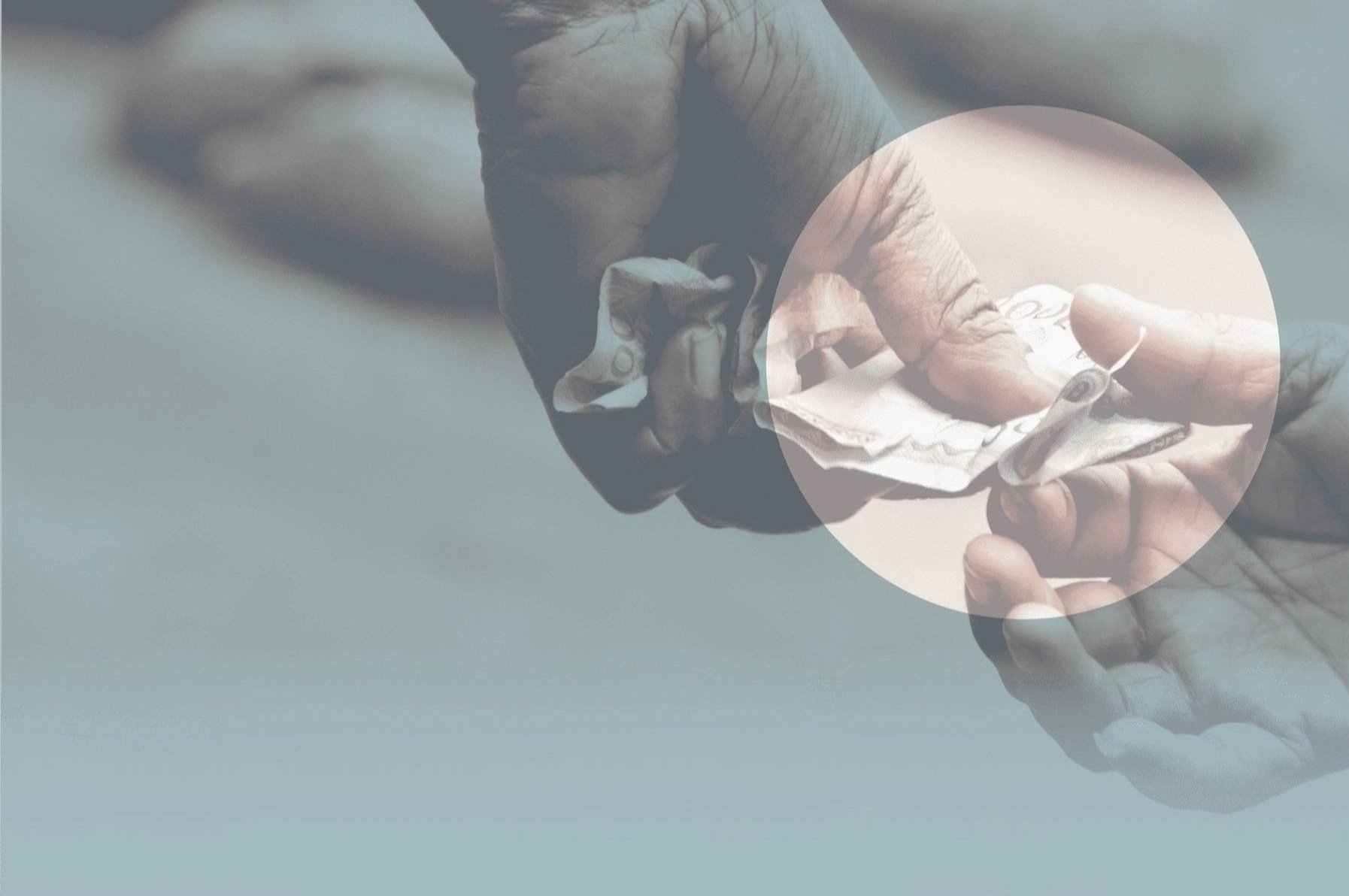
Building more effective powerful efficient impactful cash transfers using behavioral science.
Cash transfer programs are a proven anti-poverty tool. But they often fail to support recipients in reaching their long-term financial goals.
Designing for human behavior can help.
We’ve designed light-touch behavioral interventions for cash transfer programs across sub-Saharan Africa and rigorously tested their impact through randomized controlled trials (RCTs).
Emerging evidence is clear: behavioral science provides a cost-effective way for cash transfer recipients to reach their financial goals.
Explore our findings
Kenya
Goal: Recipients of Kenya’s National Safety Net Program reported having financial goals, such as starting a new business or purchasing livestock, but found it difficult to reach them. We worked with the World Bank and the Government of Kenya’s Directorate of Social Assistance to help recipients reach their goals.
Key Result: Behavioral designs substantially increased the probability that participants set a financial goal and took steps to achieve it.
Key Findings
Recipients of the behavioral interventions:
Were 9% more likely to have set a productive goal.**
Saved 41% more of their cash transfer.*
* p<0.1, ** p<0.05
Designs Tested
Posters that normalize saving
Goal-setting and planning activities
Money-partitioning pouches
Text message reminders
Test Details
Individually randomized controlled trial with 900 recipients across 6 villages conducted over one month.
Cost-Effectiveness
Behavioral interventions were:
$6.09 per person
1.5 times as effective at increasing savings then giving recipients the additional cash equivalent to the cost of the interventions.
Learn More: Project Brief | Project Report | Blog
Cost per person includes the estimated cost of delivering the intervention activities at scale, including any necessary materials, training, and associated program delivery costs. Learn how we calculated cost-effectiveness here.
Tanzania
Goal: Recipients of Tanzania’s Productive Safety Net Program expressed a desire to invest their cash transfer into income-generating activities. However, the cost of their immediate needs made it difficult to do so. We worked with the World Bank and the Government of Tanzania to design and implement behaviorally informed interventions to make saving and investing easier.
Key Result: Behavioral designs substantially increased the probability that participants set a financial goal and took steps to achieve it.
Key Findings
Recipients of the behavioral interventions:
Were 65% more likely to have saved.*
Were 22% more likely to have made a productive investment. **
* p<0.1, ** p<0.05
Designs Tested
Self-affirmation activities
Posters that normalize saving and investing
Goal-setting and plan-making activities
Money-partitioning pouches
Test Details
Cluster randomized controlled trial in 64 villages across Tanzania with over 2,600 recipients, conducted over six months.
Cost-Effectiveness
Behavioral interventions were:
$4.89 per person
1.5 times more effective at increasing savings than simply giving the equivalent cash amount used to implement them.
Learn More: Project Brief
Cost per person includes the estimated cost of delivering the intervention activities at scale, including any necessary materials, training, and associated program delivery costs. Learn how we calculated cost-effectiveness here.
Democratic Republic of the Congo
Goal: Recipients of a cash transfer program for urban residents experiencing poverty in Kinshasa reported having trouble following through on their productive goals and priorities. We worked with the World Bank and the government of the Democratic Republic of the Congo to design and test behaviorally informed text messages to encourage recipients to follow through on spending their cash transfers in line with their priorities.
Key Result: Text message reminders significantly increased the probability that recipients defined a spending priority and spent in line with that priority.
Key Findings
Recipients of the behavioral text messages:
Were 3% more likely to define a spending priority.*
Were 4% more likely to spend in line with their priority.**
* p<0.1, ** p<0.05
Designs Tested
Two text messages sent to participants:
The first was sent before distributing cash, prompting participants to think of their priority and write down a budget.
The second was sent just after distributing cash, reminding participants to spend accordingly.
Test Details
Individually randomized controlled trial with 30,000 cash transfer recipients conducted over a one-month period.
Cost-Effectiveness
Behavioral interventions were:
$0.22 per person
8.25 times more effective at increasing the amount spent toward participants’ priorities than giving the equivalent cash amount used to implement them.
Learn More: Project Brief
Cost per person includes the estimated cost of delivering the intervention activities at scale, including any necessary materials, training, and associated program delivery costs. Learn how we calculated cost-effectiveness here.
South Sudan
Goal: Recipients of the South Sudan Social Safety Net Project reported struggling to meet both their basic and longer-term needs in the face of conflict, food insecurity, natural disasters, the COVID-19 pandemic, and the depreciation of the South Sudanese pound. We worked with the World Bank, Government of South Sudan, and the United Nations Office of Project Services to design and test behavioral interventions to help recipients identify and reach their financial goals.
Key Result: Behavioral designs significantly increased the proportion of the transfer that recipients spent on their self-identified priority.
Key Findings
Recipients of the behavioral interventions:
Were 4% more likely to have set a priority for their spending.**
Spent 7% more of their transfer on their identified priority.*
* p<0.1, ** p<0.05
Designs Tested
Goal-setting activity
Goal-prioritization activity
Budgeting envelopes
Posters that combat false narratives about poverty
Test Details
Individually randomized controlled trial with 900 participants across 17 villages conducted over a one-month period.
Cost-Effectiveness
Behavioral interventions were:
$2.50 per person
1.2 times more effective at increasing the amount spent toward participants’ priorities than giving the equivalent cash amount used to implement them.
Learn More: Project Brief
Cost per person includes the estimated cost of delivering the intervention activities at scale, including any necessary materials, training, and associated program delivery costs. Learn how we calculated cost-effectiveness here.
Madagascar
Goal: Recipients of the Human Development Cash Transfer program reported wanting to use their cash transfer to improve their child’s development and help their children escape poverty. We worked with the World Bank and the Government of Madagascar to create behaviorally designed interventions that support early childhood development.
Key Result: Behavioral designs increased food security and improved child development outcomes, desirable parenting behaviors, and the daily number of meals prepared in a household.
Key Findings
Recipients of the cash transfer program who received the planning treatment exercise:
Scored 5% higher on a scale measuring positive parenting practices.**
Were 32% more likely to prepare diverse meals.**
Scored 200% higher on language learning assessments (0.12 standard deviation increase).*
* p<0.1, ** p<0.05
Designs Tested
Creation of mother leader groups
Plan-making tools
Self-affirmation activities
Test Details
Cluster randomized controlled trial in 379 villages, conducted over 18 months.
Cost-Effectiveness
Behavioral interventions were:
$14.04 per person for plan-making and self-affirmation treatments
1.5 times more effective at improving childhood development outcomes then giving participants the equivalent amount of cash used to implement the programs.
Learn More: Journal Article | Project Brief | Working Paper
Cost per person includes the estimated cost of delivering the intervention activities at scale, including any necessary materials, training, and associated program delivery costs. Learn how we calculated cost-effectiveness here.
Ethiopia
Goal: Cash transfer recipients in the Urban Productive Safety Net Program reported intentions to start and/or expand their businesses; however, many recipients faced barriers in acting on their intentions. ideas42 worked with the World Bank and the Government of Ethiopia to create behavioral interventions that could help close this gap.
Key Result: Behavioral designs significantly increased the probability that recipients thought about and planned how to allocate their grant money and savings.
Key Findings
Recipients of the behavioral interventions:
Were 6% more likely to have thought about and planned how to allocate their transfer.**
* p<0.1, ** p<0.05
Designs Tested
Posters that normalize people saving
Self-affirmation activities
Planning and allocation activities
Test Details
Individually randomized controlled trial with 2,350 recipients, conducted over six months.
Cost-Effectiveness
Behavioral interventions were:
$3.75 per person
5.8 times more effective at increasing participant planning their spending in line with their priorities than giving the equivalent amount of cash used to implement the programs.
Learn More: Project Brief
Cost per person includes the estimated cost of delivering the intervention activities at scale, including any necessary materials, training, and associated program delivery costs. Learn how we calculated cost-effectiveness here.
Ghana
Goal: Participants of the productive inclusion component of the Ghana Productive Safety Net Project reported challenges with being able to consistently save their cash transfers and apply business principles towards growing sustainable income-generating activities. ideas42 worked with the Government of Ghana and the World Bank to design behavioral interventions to help recipients save, invest, and start taking steps to start or grow their businesses.
Key Result: Behavioral designs significantly increased the incidence of saving among recipients, as well as plan-making and goal-setting behaviors related to saving.
Key Findings
Recipients of the behavioral interventions:
Were 17% more likely to have set business-related goals.***
Were 24% more likely to know how much money they need to save to reach their goal.***
Were 10% more likely to have saved in the past 12 months.***
* p<0.1, ** p<0.05, *** p<0.01
Designs Tested
Goal-setting and plan-making tools
Posters that normalize people saving
Savings tracking tool and storage box
Pamphlets that help people track their progress
Test Details
Cluster randomized controlled trial in 104 CLASS communities with over 3,000 recipients, conducted over 12 months.
Cost-Effectiveness
Behavioral interventions were:
$5.82 per person
3.6 times more effective at improving savings likelihood than giving participants the equivalent amount of cash used to implement them.
Learn More: Project Brief
Cost per person includes the estimated cost of delivering the intervention activities at scale, including any necessary materials, training, and associated program delivery costs. Learn how we calculated cost-effectiveness here.
Behavioral barriers often prevent people from making decisions in line with their goals. These barriers are exacerbated for people living in poverty and the resulting conditions of chronic scarcity, as they are a significant drain on mental bandwidth and attention.
Behavioral design helps people overcome them.
Explore our designs
Ready to learn more about using behavioral science to improve your cash transfer program?
comparison
Cross-Country Comparison
Tools
Tools for practitioners
Explore ready-to-use tools and key takeaways from our range of work using behavioral science to enhance cash transfer programs.
-
A Behavioral Approach to Cash Transfers for Productive Investments
A Behavioral Approach to Cash Transfers for Early Childhood Development
Behavioral insights to better design social protection cash transfers in emergencies [English]
Behavioral insights to better design social protection cash transfers in emergencies [French]
-
A Behavioral Approach to Cash Transfers for Productive Investments
A Behavioral Approach to Cash transfers for Early Childhood Development
Behavioral insights to better design social protection cash transfers in emergencies [English]
Behavioral insights to better design social protection cash transfers in emergencies [French]
-
-
-
Improving Business Planning among Cash Transfer Recipients in Ethiopia
Helping Cash Transfer Recipients Reach Financial Goals in Kenya
Increasing Savings Among Cash Transfer Recipients in Tanzania
Increasing Resilience Through Cash Transfers in Kinshasa
Better Cash Transfer Programs in South Sudan
Behavioral Nudges for Cash Transfer Programs in Madagascar
Developing Saving Behaviors Among Cash Transfer Recipients in Ghana
methodology
Our Unique Methodology
We use a rigorous methodology to uncover behavioral barriers that limit the impact of programs, services, policies, and products. Then, we design tailored solutions—informed by behavioral science—that address barriers and make programs more impactful for those we seek to serve.
Designed with adapting and scaling in mind, our evidence-backed interventions can now be easily integrated into existing cash transfer programs. We, alongside partners like the World Bank, have used these principles to guide our use of behavioral science to improve social protection programs around the world.
Learn more about how behavioral science can increase the impact of anti-poverty programs in our report.
Contact
Our interventions are designed with adapting and scaling in mind.
Fill out the form to speak to one of our behavioral science experts.
We’re redesigning the future of cash transfer programs.
With a growing body of evidence, we're working to adapt and scale designs for new programs and contexts.
